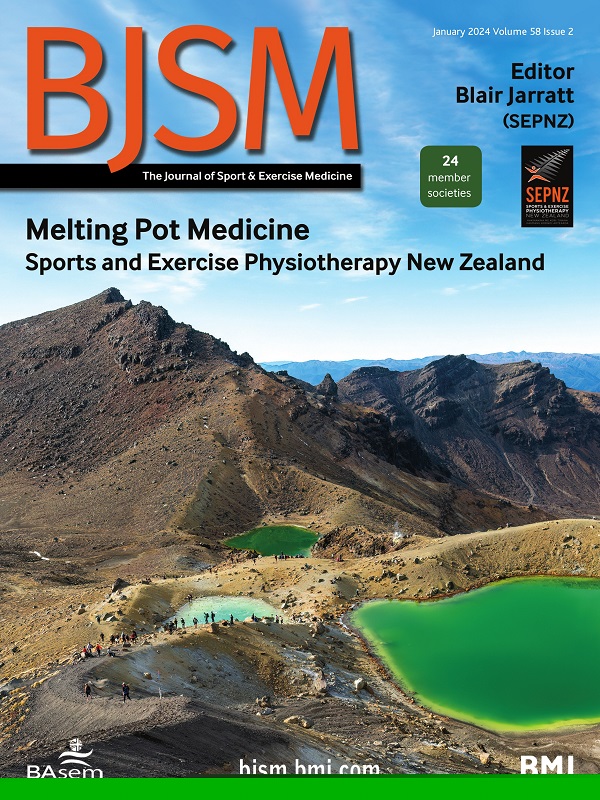Domain-specific physical activity and mental health: an updated systematic review and multilevel meta-analysis in a combined sample of 3.3 million people
IF 16.2
1区 医学
Q1 SPORT SCIENCES
引用次数: 0
Abstract
Objective To update, synthesise and provide meta-analytical evidence of the associations between domain-specific physical activity (PA) and mental health and mental ill-health outcomes. Design Systematic review and multilevel meta-analysis. Data sources In March 2024, we systematically searched five databases. Eligibility criteria Methods employed replicated those of a previous review in 2017. All studies examining associations between domain-specific PA and specified mental health outcomes were included. Results 372 studies met inclusion criteria and 361 were included in the meta-analysis. Across the 372 studies (combined sample size of 3 323 711), 338 examined leisure-time PA, 54 work-related PA, 72 transport-related PA, 44 household PA, 5 school sport and 8 physical education. Multilevel meta-analyses showed that leisure-time PA (r=0.205, 95% CI 0.157 to 0.253), transport-related PA (r=0.138, 95% CI 0.042 to 0.231) and household PA (r=0.096, 95% CI 0.025 to 0.165) were positively associated with mental health . Leisure-time PA (r=−0.149, 95% CI −0.189 to –0.11) and school sport (r=−0.096, 95% CI −0.115 to –0.077) were inversely associated with mental ill health . However, work-related PA (r=0.134 95% CI 0.069 to 0.199) was positively associated with mental ill health . Conclusion The direction of the association between PA and mental health/mental ill health is dependent on the domain in which PA occurs. Promoting PA for leisure purposes is likely to yield the greatest benefits for both promoting mental health and preventing mental ill health. As such, leisure-time PA should be prioritised in messaging, guidelines and interventions/programmes designed to support mental health through PA. PROSPERO registration number CRD42024510303. Data are available upon reasonable request. All data relevant to the study are included in the article or uploaded as supplementary information. Data are viewable in [online supplemental file 5][1]. All other data are available upon reasonable request. [1]: #DC5特定领域的身体活动和心理健康:330万人联合样本的最新系统综述和多层次荟萃分析
目的更新、综合并提供领域特异性体力活动(PA)与心理健康和精神疾病结局之间关联的meta分析证据。设计系统评价和多层次荟萃分析。2024年3月,我们系统地检索了5个数据库。采用的方法与2017年的前一次综述相同。所有检查特定领域PA与特定心理健康结果之间关系的研究均被纳入。结果372项研究符合纳入标准,361项纳入meta分析。在372项研究中(总样本量为3 323 711),338项研究调查了休闲时间的PA, 54项与工作有关的PA, 72项与交通有关的PA, 44项家庭PA, 5项学校运动和8项体育。多水平荟萃分析显示,休闲时间PA (r=0.205, 95% CI 0.157 ~ 0.253)、交通相关PA (r=0.138, 95% CI 0.042 ~ 0.231)和家庭PA (r=0.096, 95% CI 0.025 ~ 0.165)与心理健康呈正相关。休闲时间PA (r= - 0.149, 95% CI - 0.189至-0.11)和学校体育(r= - 0.096, 95% CI - 0.115至-0.077)与精神疾病呈负相关。然而,与工作相关的PA (r=0.134, 95% CI 0.069至0.199)与精神疾病健康呈正相关。结论PA与心理健康/心理不健康的关系方向取决于PA发生的领域。推广以休闲为目的的体育活动,可能对促进心理健康和预防心理疾病都有最大的好处。因此,在信息传递、指导方针和干预措施/方案中应优先考虑闲暇时间的活动,以便通过活动支持心理健康。普洛斯彼罗注册号CRD42024510303。如有合理要求,可提供资料。所有与研究相关的数据都包含在文章中或作为补充信息上传。数据可在[在线补充文件5][1]中查看。如有合理要求,可提供所有其他资料。[1]: # DC5
本文章由计算机程序翻译,如有差异,请以英文原文为准。
求助全文
约1分钟内获得全文
求助全文
来源期刊
CiteScore
27.10
自引率
4.90%
发文量
217
审稿时长
3-8 weeks
期刊介绍:
The British Journal of Sports Medicine (BJSM) is a dynamic platform that presents groundbreaking research, thought-provoking reviews, and meaningful discussions on sport and exercise medicine. Our focus encompasses various clinically-relevant aspects such as physiotherapy, physical therapy, and rehabilitation. With an aim to foster innovation, education, and knowledge translation, we strive to bridge the gap between research and practical implementation in the field. Our multi-media approach, including web, print, video, and audio resources, along with our active presence on social media, connects a global community of healthcare professionals dedicated to treating active individuals.

 求助内容:
求助内容: 应助结果提醒方式:
应助结果提醒方式:


